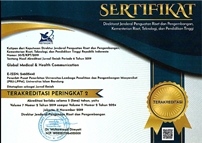Community Participation and Mosquito Breeding Sites in Cimahi City: Current Conditions and Challenges in Dengue Fever Control
Abstract
In 2021, Cimahi City recorded the 5th highest dengue fever (DF) cases among 27 districts/cities in West Java. Efforts to control DF have been going on for several decades, with one strategy being to involve community participation in eliminating mosquito breeding sites. This research evaluated community participation in Cimahi city by identifying mosquito breeding locations inside and outside the home. Samples were taken from 15 sub-districts in Cimahi city. The research population involved houses in 15 sub-districts, with a total sample of 1,560 houses representing each sub-district. Larval sampling was carried out in various water reservoirs, both natural and artificial, around residential areas. The successfully taken larvae were then identified and counted in the laboratory. The research showed that the most dominant mosquito breeding place was in bucket-type containers, namely 130 units (3.2%). Entomological data produced a free larva index (FLI) of 79.23%, a house index (HI) of 20.7%, a container index (CI) of 8.07%, and a Breteau index (BI) of 20.5%. This finding indicated a lack of community involvement in preventing vector-borne diseases by eliminating breeding sites. Cimahi city still had the potential to spread vector-borne diseases.
Keywords
Full Text:
PDFReferences
Lolan YP. The role of cadres in providing prevention of dengue hemorrhagic fever (DHF) in Bandung city. Int J Health Med Res. 2023;2(10):350–3.
Kementerian Kesehatan Republik Indonesia. Profil kesehatan Indonesia tahun 2020. Jakarta: Kementerian Kesehatan Republik Indonesia; 2021.
Mouatassem TF, El Ouali Lalami A, Faraj C, Rais N, Guemmouh R. Study of abiotic and biotic parameters affecting the abundance of mosquito larvae (Diptera: Culicidae) in the region of Fez (Morocco). Int J Zool. 2020;2020(1):5429472.
Ong J, Liu X, Rajarethinam J, Yap G, Ho D, Ng LC. A novel entomological index, Aedes aegypti breeding percentage, reveals the geographical spread of the dengue vector in Singapore and serves as a spatial risk indicator for dengue. Parasit Vectors. 2019;12(1):17.
Dharmamuthuraja D, Rohini PD, Lakshmi MI, Isvaran K, Ghosh SK, Ishtiaq F. Determinants of Aedes mosquito larval ecology in a heterogeneous urban environment: a longitudinal study in Bengaluru, India. PLoS Negl Trop Dis. 2023;17(11):e0011702.
Pinchoff J, Silva M, Spielman K, Hutchinson P. Use of effective lids reduces presence of mosquito larvae in household water storage containers in urban and peri-urban Zika risk areas of Guatemala, Honduras, and El Salvador. Parasit Vectors. 2021;14(1):167.
Agus Nurjana M, Srikandi Y, Wijatmiko TJ, Hidayah N, Isnawati R, Octaviani O, et al. Water containers and the preferable conditions for laying eggs by Aedes mosquitoes in Maros Regency, South of Sulawesi, Indonesia. J Water Health. 2023;21(11):1741–6.
Ngugi HN, Mutuku FM, Ndenga BA, Musunzaji PS, Mbakaya JO, Aswani P, et al. Characterization and productivity profiles of Aedes aegypti (L.) breeding habitats across rural and urban landscapes in western and coastal Kenya. Parasit Vectors. 2017;10(1):331.
Taylor HM, Karlin S. An introduction to stochastic modeling. 3rd Edition. New York: Academic Press; 1998.
Lukubwe O, Mwema T, Joseph R, Maliti D, Iitula I, Katokele S, et al. Baseline characterization of entomological drivers of malaria transmission in Namibia: a targeted operational entomological surveillance strategy. Parasit Vectors. 2023;16(1):220.
McCann RS, van den Berg H, Diggle PJ, van Vugt M, Terlouw DJ, Phiri KS, et al. Assessment of the effect of larval source management and house improvement on malaria transmission when added to standard malaria control strategies in southern Malawi: study protocol for a cluster-randomized controlled trial. BMC Infect Dis. 2017;17(1):639.
World Health Organization. Monitoring and managing insecticide resistance in Aedes mosquito populations: interim guidance for entomologists [Internet]. Geneva: World Health Organization; 2016 [cited 2023 Sep 10]. Available from: https://iris.who.int/bitstream/10665/204588/2/WHO_ZIKV_VC_16.1_eng.pdf.
Gervetauskas M. The essentials of water reservoir construction [Internet]. San Fransisco: Academia, Inc.; 2022 [cited 2023 Sep 14]. Available from: https://www.academia.edu/112387394/The_Essentials_of_Water_Reservoir_Construction.
Keshmiry A, Hassani S, Mousavi M, Dackermann U. Effects of environmental and operational conditions on structural health monitoring and non-destructive testing: a systematic review. Buildings. 2023;13(4):918.
Peraturan Menteri Kesehatan Republik Indonesia Nomor 2 Tahun 2023 tentang Peraturan Pelaksanaan Peraturan Pemerintah Nomor 66 Tahun 2014 tentang Kesehatan Lingkungan.
Prasad SK, Lane C, Glandon D. Rapid evidence assessment of the impacts of sewerage, drainage, and piped water chlorination in urban settings of low- and middle-income countries. J Water Sanit Hyg Dev. 2021;11(2):179–94.
Liu Z, Ying J, He C, Guan D, Pan X, Dai Y, et al. Scarcity and quality risks for future global urban water supply. Landsc Ecol. 2024;39:10.
Dom NC, Camalxaman SN, Ab Rahman MH. Inferring the temporal dissemination patterns of Aedes indices and weather variables in Penang: a five-year study. Health Scope. 2019;1:219–24.
Ridha MR, Rahayu N, Rosvita NA, Setyaningtyas DE. Hubungan kondisi lingkungan dan kontainer dengan keberadaan jentik nyamuk Aedes aegypti di daerah endemis demam berdarah dengue di Kota Banjarbaru. J Buski. 2013;4(3):133–7.
Mading M, Kazwaini M. Ekologi Anopheles spp. di Kabupaten Lombok Tengah. Aspirator. 2014;6(1):13–20.
DOI: https://doi.org/10.29313/gmhc.v13i1.14241
pISSN 2301-9123 | eISSN 2460-5441
Visitor since 19 October 2016:
Global Medical and Health Communication is licensed under a Creative Commons Attribution-NonCommercial-ShareAlike 4.0 International License.
- https://jurnal.narotama.ac.id/
- https://www.spb.gba.gov.ar/campus/
- https://revistas.unsaac.edu.pe/
- https://proceeding.unmuhjember.ac.id/
- https://ejournal.uki.ac.id/
- https://random.polindra.ac.id/
- https://jurnal.politeknik-kebumen.ac.id/
- https://scholar.ummetro.ac.id/
- https://ejournal.uika-bogor.ac.id/
- https://journals.telkomuniversity.ac.id/
- https://www.iejee.com/
- https://e-journal.iainptk.ac.id/
- https://journal.stitpemalang.ac.id/
- https://revistas.unimagdalena.edu.co/
- https://catalogue.cc-trieves.fr/
- https://revistas.tec.ac.cr/
- https://jurnal.poltekapp.ac.id/
- https://ojs.adzkia.ac.id/
- https://journal.umpalopo.ac.id/
- https://journal.unifa.ac.id/































.png)
_(1).png)
_(1).jpg)
